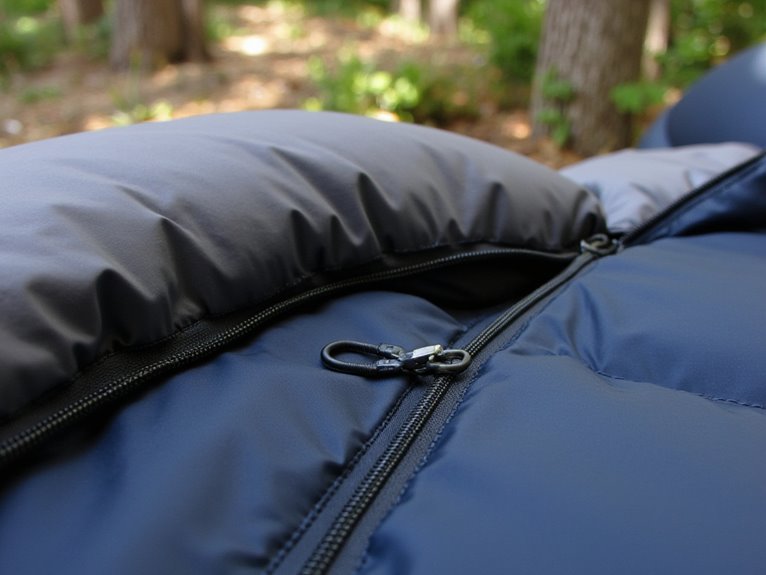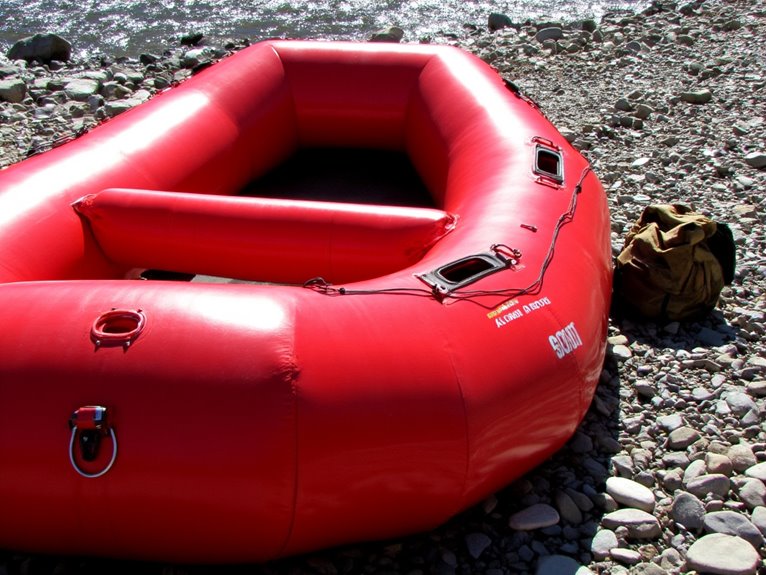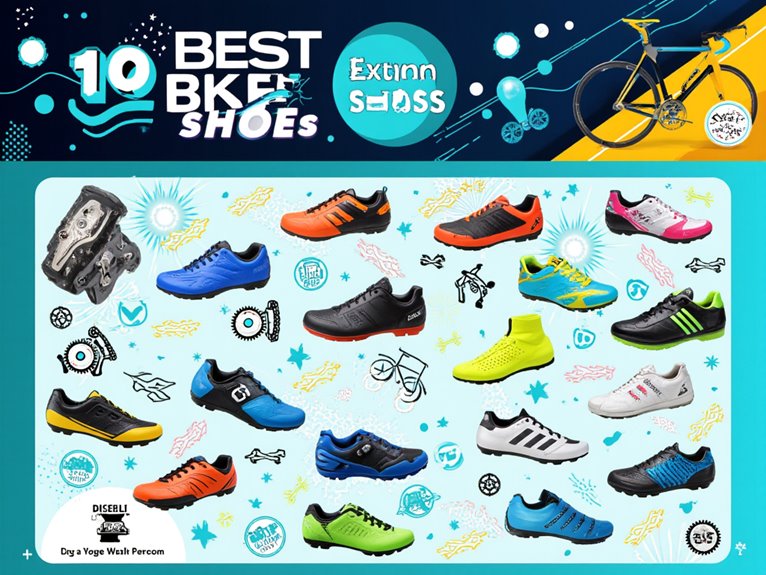Sleeping Bag Features That Actually Matter (vs. Marketing Gimmicks)
Focus on insulation type, construction quality, and realistic temperature ratings rather than flashy features. Down offers 15-20% better warmth-to-weight ratios but loses insulation when wet, while synthetic retains 80% performance in moisture. Box baffle construction prevents cold spots that sewn-through designs create. ISO 23537 ratings provide reliable temperature guidelines versus inflated brand claims. Draft collars and insulated hoods deliver actual warmth benefits, while complex zipper systems add unnecessary weight. Understanding these fundamentals reveals which premium features justify their cost.
We are supported by our audience. When you purchase through links on our site, we may earn an affiliate commission, at no extra cost for you. Learn more. Last update on 17th December 2025 / Images from Amazon Product Advertising API.
Notable Insights
- Box baffle construction prevents cold spots while sewn-through designs create thermal bridges that reduce warmth.
- ISO 23537 and EN 13537 temperature ratings provide reliable performance benchmarks versus inflated proprietary brand claims.
- Draft collars and insulated hoods retain body heat effectively, while complex zipper systems add weight without meaningful benefits.
- Premium fabric names like Pertex Quantum matter less than actual denier ratings for durability versus weight trade-offs.
- Proper loft and fit determine warmth more than marketing features; focus on construction quality over flashy additions.
Insulation Type: Down vs. Synthetic Performance Reality
When you’re choosing between down and synthetic insulation for your sleeping bag, you’re making a decision that’ll affect every night you spend outdoors.
Down advantages center on superior warmth-to-weight ratios and exceptional compressibility. Quality down provides 15-20% better warmth per ounce than synthetic alternatives while packing down to half the size.
However, synthetic drawbacks aren’t the complete story. Modern synthetic fills retain 80% insulative power when wet, unlike down’s complete loss of loft.
Down requires meticulous care—avoiding moisture exposure and ensuring proper drying to maintain performance. With proper maintenance, down lasts 15-20 years versus synthetic’s typical 5-8 year lifespan.
Down insulation demonstrates 18 times less climate impact than polyester fill, reducing environmental impacts by 85% to 97% compared to synthetics.
Choose down for dry conditions and weight-critical applications. Select synthetic for wet climates, budget constraints, or low-maintenance requirements. Your environment determines the right choice.
Weight and Packability: What the Numbers Actually Mean
While manufacturers often quote sleeping bag weights that seem impressively low, these numbers frequently exclude essential components like stuff sacks, compression straps, and storage bags that can add 2-4 ounces to your actual pack weight.
Advertised sleeping bag weights often omit stuff sacks and compression gear, adding 2-4 ounces to your actual pack weight.
Your sleep system’s weight distribution matters more than individual component weights. A complete system typically weighs 4-7 pounds, with the sleeping bag comprising 60-70% of that total.
Premium down bags weighing 2-3 pounds compress to 6-8 liters, while synthetic alternatives occupy 8-12 liters at similar weights.
Compressibility factors directly impact your pack’s efficiency. High-fill-power down (800+) compresses 25-30% better than synthetic insulation. Mummy bags save 8-12 ounces compared to rectangular designs.
For ultralight backpacking, target 1-3 pound bags. Standard backpacking accommodates 2-4 pound options without exceeding the 20% body weight rule.
Compression sacks can reduce sleeping bag dimensions to approximately 11 x 6.3 inches, making them essential for optimizing pack space and maintaining gear organization on multi-day trips.
Temperature Ratings: Beyond the Marketing Labels
You’ve probably noticed that sleeping bag temperature ratings vary wildly between brands, with some bags claiming comfort at 20°F while others with identical-looking specs fall short of their promises.
The key to understanding these numbers lies in recognizing that standardized ISO 23537 and EN 13537 testing protocols create reliable benchmarks, while proprietary manufacturer ratings often inflate performance claims.
Beyond the lab numbers, your actual warmth depends on factors like sleeping pad R-value, tent ventilation, and personal metabolism—variables that no standardized test can fully capture.
The insulation type you choose also significantly impacts real-world temperature performance, with down excelling in dry conditions while synthetic materials maintain their thermal properties even when exposed to moisture.
ISO Standards Explained
Marketing claims about sleeping bag temperature ratings often mislead consumers with unrealistic promises of warmth and comfort. That’s where ISO 23537-1:2016 sleeping bag standards provide scientific reliability.
This international protocol uses thermal mannequins in controlled laboratory conditions to measure actual insulation performance, eliminating manufacturer bias.
The standardized testing delivers four critical data points for temperature rating comparison:
- COMFORT rating – Sleep comfortably in relaxed position
- LIMIT rating – Survive curled up, marking performance boundaries
- EXTREME rating – Six-hour emergency survival threshold
- Standardized conditions – Foam pad simulation secures consistent results
You’ll find ISO-compliant labels on quality sleeping bags from reputable manufacturers. These aren’t marketing gimmicks—they’re laboratory-verified measurements using instrumented mannequins that monitor energy requirements to maintain core temperature.
This scientific approach accounts for individual warmth variations while providing baseline performance data you can rely on.
Real-World Performance Factors
Even with ISO-standardized testing providing reliable baseline data, your sleeping bag’s actual performance in the field depends on variables that no laboratory can fully replicate.
Wind, moisture, and uneven surfaces aren’t present in climate-controlled lab environments. Your sleeping postures during actual sleep differ greatly from the standardized curled position used in testing, directly affecting thermal performance.
Lab manikins use electrical power to simulate body heat, while you rely on metabolism and insulation—a fundamental difference.
Your bag’s loft decreases through packing compression, moisture absorption, and movement during sleep. Ground conditions, pad R-value, sleepwear choices, and humidity levels all impact warmth retention.
Additionally, insulation compression from repeated use reduces thermal efficiency over time, something initial lab ratings don’t account for.
Essential Cold Weather Features That Save Lives
When temperatures drop below freezing, your sleeping bag’s draft protection systems become the difference between a restful night and a dangerous bout with hypothermia.
Draft collars that seal around your neck prevent warm air from escaping while blocking cold air infiltration – a critical barrier that can maintain your core temperature by several degrees.
An insulated hood with proper construction wraps your head and neck area, where you lose up to 40% of your body heat, creating a complete thermal envelope that keeps you alive in sub-zero conditions.
Quality dual zippers with enhanced webbing not only provide smooth operation in freezing conditions but also allow precise temperature control while minimizing heat loss during adjustments.
Draft Protection Systems
Two critical components form the backbone of effective draft protection in cold-weather sleeping bags: draft collars and draft tubes.
Draft collar benefits include preventing the bellows effect when you move during sleep, using a tube of down-filled fabric secured with flat clips below the hood.
Draft tube function centers on blocking cold air infiltration through zippers with insulated barriers.
These systems work together to maintain your core temperature:
- Draft collars seal the neck area – preventing precious warm air from escaping upward
- Draft tubes eliminate zipper cold spots – blocking frigid air from penetrating interior spaces
- Combined protection creates thermal barriers – maintaining consistent interior temperatures throughout the night
- Premium bags integrate both features – delivering extensive draft protection for extreme conditions
Insulated Hood Construction
Beyond thorough draft protection, your sleeping bag’s hood represents the most critical component for preventing life-threatening heat loss in extreme conditions.
Your head releases up to 40% of body heat, making proper hood insulation absolutely essential for survival temperatures.
Effective hood construction requires vertical baffles that distribute insulation evenly around your head. VTC (Vertical Tube Construction) prevents insulation migration and eliminates cold spots.
The ergonomic design should contour naturally to your head shape while providing adjustable closure systems.
Face gaskets create thermal seals around your face, preventing cold air infiltration.
Quality hoods feature curved construction techniques like WaveLoft™ that maximize loft retention. Diagonal layering or concertina construction enhances thermal performance by trapping more air pockets, directly improving heat retention efficiency in sub-zero conditions.
Construction Quality: Built to Last vs. Built to Sell
The difference between a sleeping bag that’ll serve you for decades and one that falls apart after a few seasons comes down to construction quality—specifically how manufacturers approach seam construction, insulation distribution, and structural reinforcement.
Premium bags utilize box baffle design to prevent insulation shifting, while budget models rely on sewn-through construction that creates cold spots. Welded seams eliminate needle holes, enhancing seam durability and moisture resistance.
Construction robustness shows in these critical areas:
- Double-stitched stress points at zippers and shoulders prevent catastrophic failure
- Internal baffling systems maintain insulation loft and prevent cold bridges
- Heavy-duty zippers with anti-snag mechanisms survive thousands of cycles
- Abrasion-resistant panels protect high-wear zones from premature deterioration
Look for ISO 23537-1:2016 certification and independent lab testing verification. Quality manufacturers often back their construction with 3-5 year warranties, demonstrating confidence in their build quality and providing better long-term value despite higher upfront costs.
Shell Materials and Fabric Technology That Works
While construction quality determines how long your sleeping bag survives, the outer shell fabric directly impacts how well it performs in real-world conditions.
Shell durability varies dramatically between ultralight and general-use bags. Ultralight bags use 10-20 denier ripstop nylon or polyester, while durable options range from 30-80 denier. Higher denier fabrics resist tears and abrasion but add weight.
Fabric breathability prevents moisture buildup inside your bag. DWR (durable water repellent) finishes resist water without eliminating breathability. Premium fabrics like Pertex Quantum balance ultralight weight with adequate durability. eVENT fabric offers superior moisture management for high-end bags.
Choose shell materials based on your priorities. Ultralight fabrics work for careful users seeking weight savings. Heavier fabrics suit frequent use and rough conditions. DWR treatments aren’t waterproofing—you’ll still need proper storage protection.
Many bags now feature waterproof 290T nylon construction that provides enhanced protection against moisture while maintaining reasonable weight for three-season use.
Marketing Myths: Overpriced Features You Don’t Need
Manufacturers often exploit consumer uncertainty about sleeping bag performance by promoting features that sound impressive but deliver minimal real-world benefits.
Marketing gimmicks prey on buyer confusion, pushing flashy features that barely improve actual sleeping comfort or warmth retention.
You’ll encounter exaggerated temperature ratings that don’t reflect actual field conditions due to inconsistent testing methods. Premium materials command higher prices without delivering proportional performance gains for most users.
Here are four overpriced features to avoid:
- Brand name premiums that inflate costs without improving warmth
- Complex zipper systems that add weight but minimal functionality
- Excessive compression features that sacrifice durability for marginal space savings
- Misleading four-season ratings when three-season bags suffice for most conditions
Focus your bag purchase tips on proven essentials: adequate loft, proper fit, and sleeping pad importance.
An R-5+ pad matters more than fancy fabric treatments for cold-weather performance. While sleeping bags get most of the attention, the thickness is crucial for your overall sleep system comfort since 4-5 inch thick pads provide the optimal support and insulation from the ground.




